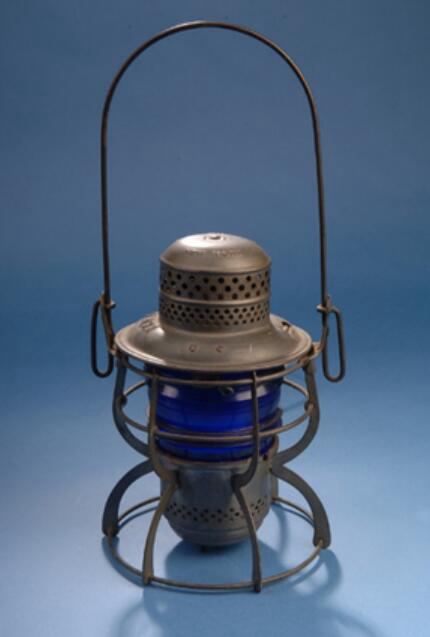
Antique Railroad Lanterns served as the sole light source in underground railways long before electric light bulbs. Although they’re way past their glory days, these aged pieces are coming back in vogue thanks to nostalgic collectors.
As a new hobbyist developing an interest in antique railroad lanterns, the greatest challenge you’ll face is identification and valuation. The different designs can be confusing, especially for unfamiliar collectors.
However, it’s easy to distinguish between them once you study the distinctive features. It’ll also help you determine the worth of each piece; hence you can make as much money as possible to sell or pay just the right amount when buying.
This guide tells you the important things about antique railroad lanterns.
Table of Contents
The History of Antique Railroad Lanterns
Fun Fact: Lanterns got their names from the thin sheet of cattle horn (Lant Horn) material used in production, according to Doctorate Holder in Antiques Appraisal, Dr. Lori. However, French Market Lanterns says the word Lantern has a Latin Origin which means torch.
Antique railroad lanterns were the primary light sources in railways used for signaling the train staff from the conductor to the linemen and Ticketmaster. They originated in the mid-1800s as fixtures in the underground railway mounted on the lantern holders through removable.
The first designs used fixed globes because they weren’t intended for constant removal or carrying around until the late-1800s (1870 – 1880). Popular lighting manufacturers Adams and Westlake revolutionized the railroad lantern and introduced the tall globe models.
With the new design, globes were now larger at 6-inches and removable, giving the wick more room to burn and the handlers easy access to replenishing the Oil. Its success led to the production of the short globes between 3¼ to 4½-inches for the line tracks.
Over time, manufacturers experimented more with designs leading to the creation of hand-held vintage railroad lanterns. These models were made exclusively for the conductors until homemakers developed an interest and it entered the general market.
Railway companies contracted sole manufacturers as suppliers of the old railroad lanterns before independent contractors started replicating designs for consumerism. So, certain brands reigned supreme for the duration of their contracts before the company changed suppliers.
Some of the most popular antique railroad lantern manufacturers include Adam and Westlake, Dietz, and Keystone. Now that you know the history of railroad lanterns, let’s get on to identification.
How to Identify an Antique Railroad Lantern
Because old railroad lanterns had several variations per model, it’s difficult for unfamiliar collectors to distinguish between them. With the renewed interest amongst hobbyists, counterfeiters have flooded the market with fake models.
Another category of fraudulent retailers mixes and matches different parts to deceive buyers. Then, some ignorant sellers overprice their antique railroad lanterns based on what they see online without a professional appraisal. When
To avoid being duped by such fraudulent or ignorant sellers who overvalue their old railroad lanterns, here are a few ways to identify original brands.
The Basic Parts of An Antique Railroad Lantern You Should Know
Every antique railroad lantern has four basic parts – The Globe, Wire Guard, Chimney, and Base. Other components include the Burner, Font, and Verticals.
The Globe
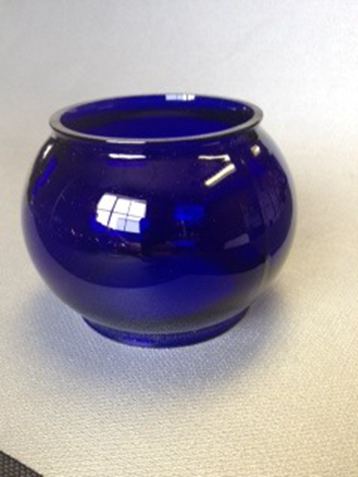
The most distinctive feature of antique railroad lanterns is the globes because you can pick them out from a distance. Globes were made of thick glass, which housed the light source and reflected the fire onto the railway.
It has a small stamped metal fitting in the smoke dome called the retainer. This device though tiny, holds the glass globe in place with a spring.
Typically, they come in three designs – Fixed, Tall, and Short.
Fixed Globe
Antique Railroad Lanterns with fixed globes are worth the most money because they are original models. They existed during the Civil War and before the world wars in the early 20th century.
Fixed glass globes, however secure they were, proved difficult to manage. It took the conductor precious time to switch it out and replenish the oils, needing something more workable.
Alas, William Westlake of Adam and Westlake created the first Tall Globe antique railroad lantern.
Tall Globe
In 1865, the first tall globe railroad lantern entered the market and became the railway favorite for about 30 to 40 years. These globes were easier to switch out, but they also came in 5 3/8 to 6-inches tall lengths.
With taller globes, antique railroad lanterns illuminated more since the length gave the light more room for reflection. It was also compatible with the preferred burning medium of the era – Oil.
Then came the first world war in 1914 and the underground railroad bombings necessitating a new type of railroad lantern – the short globe.
Short Globe
After the world wars (1946 – the 1970s), short globe railroad lanterns became the staple model. The glass globe’s height was reduced by almost making 3¼ to 4½-inches.
Unlike the previous tall-globe model, short globe railroad lanterns ran on Kerosene, the preferred fuel of the post-WWII era. Also, the shorter globe meant a smaller globe to conserve fuel.
Globes are the most reliable source of identification because they carry an etching of the brand’s name. Unfortunately, that makes it the most vulnerable since some use acid to recreate said branding on newer models.
It’s important to study the globe intently, or best, a reputable appraiser when you want to buy an expensive antique or vintage railroad lamp. For relatively cheaper models, we advise collectors to patronize reputable sellers only.
Wire Guard
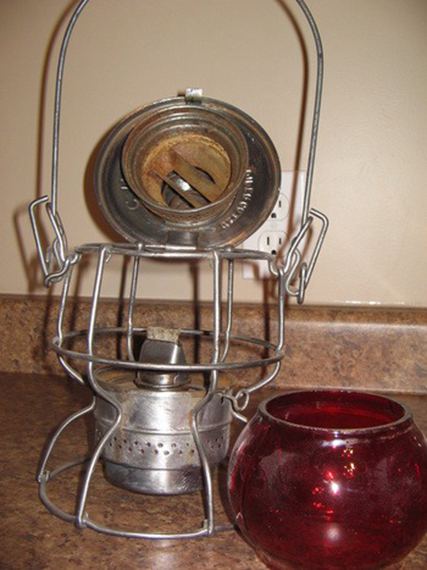
Also known as the cage, the wire guard protected the glass globe from severe damages like cracks, chips, or worse, falling off.
Other antique railroad lantern parts per Railroadiana are;
The Bail
The semi-circular handle used for carrying the lantern is the bail. It was typically made of round wire, wood, or tubular metal. Manufacturers insulated this handle for electricians to prevent hazards like electrocution.
The Base
As the name suggests, the base is the bottom of the railroad lantern that holds the Fount and grounds the device when it’s stationary. It’s a round flat surface with a deep width for holding the burning fuel.
The Burner
A small metal device inside the lantern holds the wick (the part that burns). It also connects to the control that moves the wick up and down. The burner sits on the Fount.
The Dome
On top of the railroad lantern, a small semi-circular top holds the globe retainer and lets out smoke from the burning wick.
The Fount
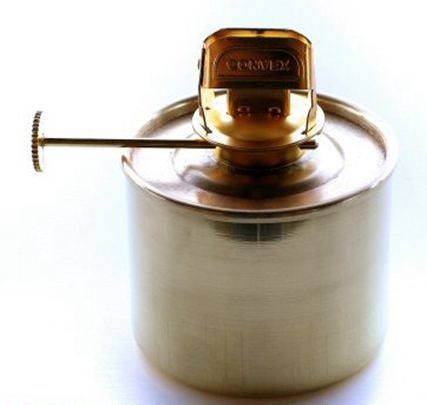
A container sitting in the lantern base is meant to hold the fuel. It also holds the burner so that the lower part of the wick sits inside it to soak up the fuel while the upper part holds the lighting fire.
The fuel types differed based on generation. The OG antique railroad lanterns made in the 19th century used Oil as burning fuel, then advanced to Kerosene around the second world war and beyond. Eventually, electricity came and phased out the need for burning fuels.
Another important aspect of the Fount is the material and mechanism, with glass being older than metal founts. The OG railroad lanterns used detachable twist-off founts, but manufacturers changed to insert founts when they got lost during oil replacement.
Unlike Twist off Founts, which require removal from the bottom after twisting the device (hence the name), the Insert Founts were placed in the base.
The Frame
The structure that holds all the parts together, including the glass globe, dome, lid, verticals, base, and Fount, is the frame.
The Horizontals
Flat wires and stampings around the globe hold it in place and secure it from external damaging factors. It’s either a single wire or double-crossed wires forming an X on either side of the globe.
The Verticals
Antique railroad lanterns had standing wires and stamps in the center, holding the top and base of the lantern. It’s part of the frame, including the cage that secures the globe. Note, however, that collectors call plate metal stamping Flat Verticals.
Although the parts of an old railroad lantern can indicate who manufactured what, it’s important to note that some brands formed collaborations and partnerships. So, not all items you find with different names on each part signify fraud or refurbishment.
That’s why it’s important to learn the history of each notable manufacturer. Keep reading to continue your brief history lesson.
Manufacturer’s Mark
Because antique railroad lanterns grew in popularity during the 19th century, manufacturers left unique marks underneath the lantern’s base to distinguish each brand. These marks prove useful today with the proliferation of railroad lanterns in the market.
In a unique twist of fate, some collectors are more interested in these markings than the actual lanterns.
Types of Railroad Lanterns
Here is a curated list of popular types of railroad lanterns
Trainman (Railroadman) Railroad Lantern
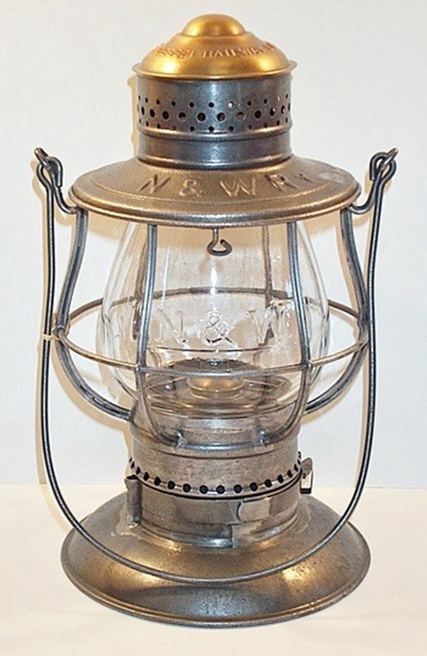
When you hear antique railroad lanterns, the immediate image that comes to the fore is the typical trainman lantern with fixed, tall, or short globes. They’re so-called because the train’s crew used them, from the conductors to the brakemen, trainmen, engineers, passenger crew, and firefighters.
Inspectors Railroad Lantern
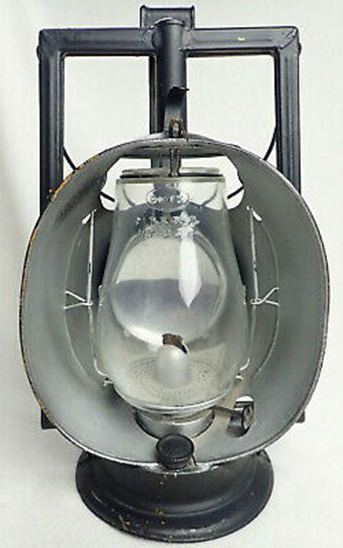
Train inspectors used hand-held railroad lanterns to conduct their searches inside train cars. Due to its purpose, the glass globe on this model produced a bright reflective light that could focus on specific subjects.
Since they were strictly utilitarian, there was no fuss about the material. Thus, Inspectors’ railroad lanterns were made of simple sheet metal that could withstand regular use without easy wear and tear.
Presentation Railroad Lantern
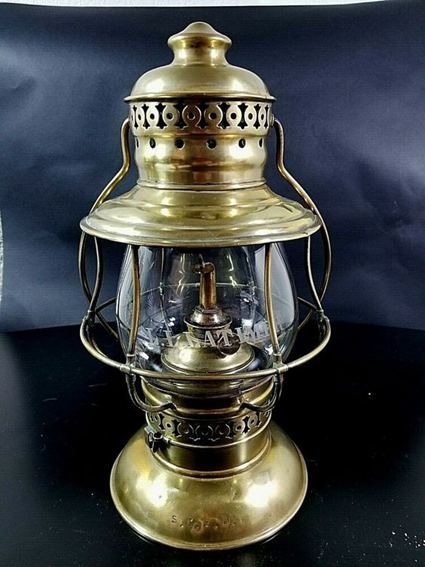
After the world wars, a fourth design was made specifically for the conductors called the presentation lantern. This model was more of an award equivalent to a plaque or trophy given to outstanding conductors for a job well done.
Collectors Weekly notes that the Presentation railroad lantern was made of fine materials such as brass, nickel-plating, and two-toned glass globes, because of its prestigious connotation. Also, it wasn’t intended for everyday use, so if you find one today, it’ll likely be intact.
Rare and Most Valuable Railroad Lantern
In this section of the article, we’ll be uncovering four of the rarest and most valuable railroad lanterns ever sold.
1. Union Pacific Tall Globe blue lantern (1925)
Price: $46,200
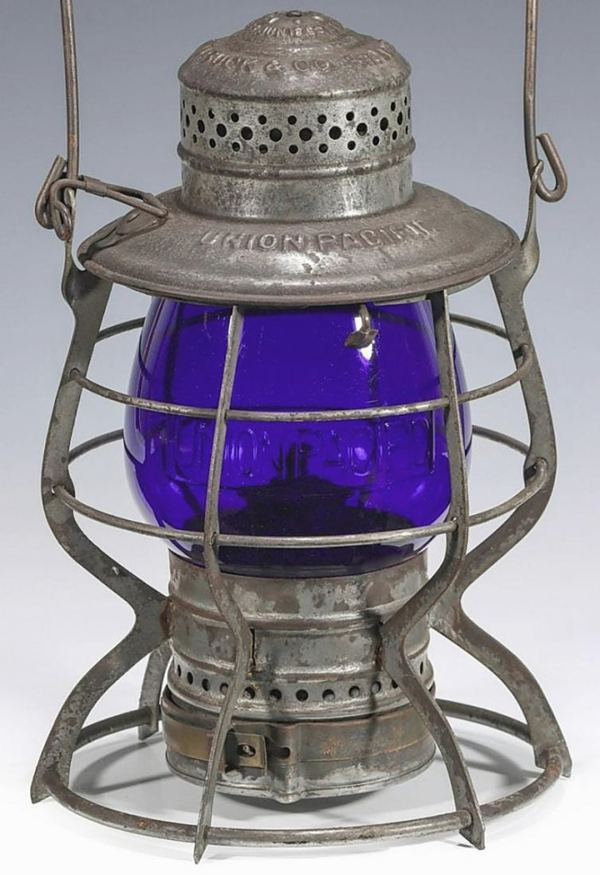
There aren’t many rare antique railroad lanterns in existence since they’re not necessary artifacts, and many of them are over 100 years old. However, a few pieces have sold for significantly high prices including this Union Pacific Tall Globe blue lantern.
While American railroad lanterns were common in the 19th and early 20th century, French models which emerged in the latter era are more eye-catching to collectors. Not only are they recent (hence often intact) but they also have unique designs.
That’s why the rarest and most valuable railroad lanterns ever sold are either French railroad lanterns or Blue-Globe American railroad lanterns. Here’s a list per 1stdibs;
2. 19th Century French Railroad Lantern
Price: $5,800
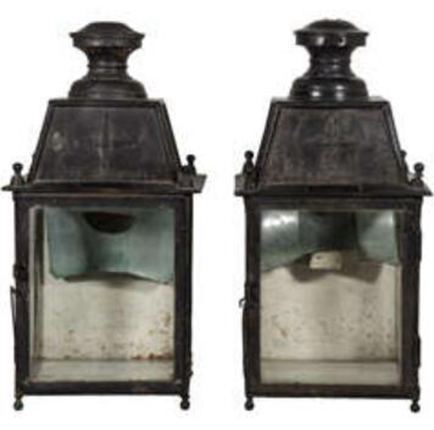
This antique French railroad lantern is made of glass, iron and Tôle, three durable materials which guaranteed its survival until its sales date. Additionally, it was sold as a set with the labels still intact so the price value increased.
3. French Railroad Lantern (1900)
Price: $2,800
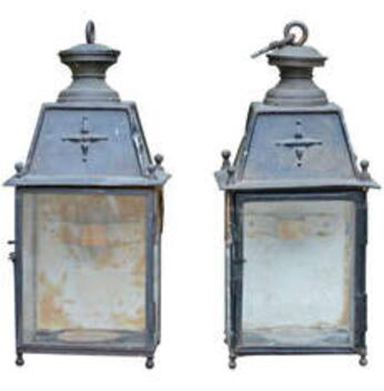
Although this two-piece railroad lantern set was made of iron (an otherwise cheap material) it scored a whopping $2,800 because of its age and condition.
4. 20th Century Brass & Copper French Railroad Lantern
Price: $2,495
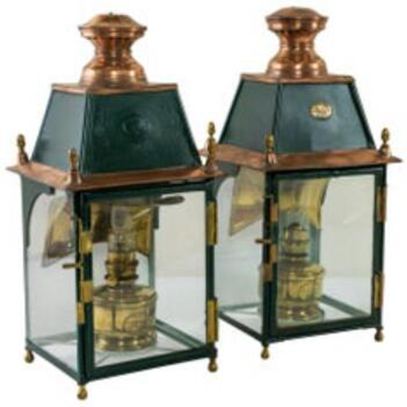
Following the principles laid down in this guide, this early 20th century railroad lantern falls into the rare category. First because it’s made of brass and copper and also because it has a unique square frame that illuminates more light.
Also, its stellar condition and polishing adds to its value.
What Makes a Railroad Lantern Valuable?
The factors surrounding the existence of an antique railroad lantern influence the price value. However, that’s not the only type of value worthy of note since some collectors don’t care about the bottom line but historical and personal significance.
Antique items, in general, are only as valuable as the amount the collector is willing to pay for them. Thus, the market determines the worth of a railroad lantern, and other factors influence the market value.
Some of the common factors that affect railroad lanterns value include;
Age, Design, Brand, Condition, and Material.
Age
The rule of thumb in the antique sale is that older items are more valuable than newer ones simply because they’re rare and often use the highest quality of materials. However, with every rule comes an exception or multiple exceptions, and the same goes for antique railroad lanterns.
Design influence trumps the age card, and you’ll learn more about that below.
Design
Each globe design on an antique railroad lamp will tell you the production era, and there are three types, as seen earlier in this guide. Fixed Globes, the most reliable model and durability, were made in the 1850s to 1870s.
Antique railroad lanterns with tall globes come next, then the most recent short globe models. Also, presentation railroad lanterns awarded to outstanding conductors, which were limited in number and thus rare in the market, command a high value.
Brand
Popular brands such as Adam & Westlake, Dietz, New York Central Line, and Star Headlight & Lantern Co. are priority models to collectors because they have rooted history and cultural significance.
However, antique railroad lanterns made by short-term manufacturers also carry high value in today’s market, albeit a minute brand in its time. “How is that possible?” you may ask. It’s because their limited existence lumps them in the rare category.
Also, since it’s not a question of whether you need an antique railroad lantern, collectors rarely bother about functionality, although it’s a plus. So, if it works fine, it can still outsell a popular model that works extraordinarily.
Old railroad lanterns with intact markings also make more money than ones without because that’s obvious proof of their originality.
Notable Brands of Old Railroad Lanterns
Adams and Westlake (A & W, Adlake)
Williams Westlake and his friend formed Adams & Westlake, a.k.a. A & W, Adlake, in 1857 to manufacture railroad supplies and hardware. In 1865, Adlake became the pioneering producer of the tall-globes and later short-globe railroad lanterns.
Adlake’s Kero lantern is the collector’s favorite because despite being a Vintage railroad lantern made for a limited 5-year period between 1930 to 1935. Its serial number ranges from 300 to 400, which you can find underneath the Fount.
The Adlake Kero has a unique underwire base formed like a caged dome with the Fount sitting inside connected at the dome’s top. It had subsequent variations until the late 1970s. Check Railroadiana for a detailed inventory of the state markings on Adlake Kero.
Armspear
Armspear Manufacturing Company launched its business in 1880 under Railroad Signal Lamp and Lantern Company. Armspear solidified itself as a reputable brand from its inception by producing lanterns with high-quality materials.
It wasn’t until 1902 that it rebranded under the Armspear name, so don’t be surprised if you see its railroad lanterns with the old RR S. L. & L. Co. markings. By 1925, the company dabbled into the production of Short Globe railroad lanterns, then partnered with Adlake six years after (1931).
The railroad lanterns produced under the Adlake x Armspear partnership had similar short globe models and used Kerosene fuel. That partnership lasted until 1960.
Brady Brass Top
As one of the failed companies of the 1800s, the Connecticut-based Brady Malleable Iron Railroad Lantern had a short-lived existence. Although an unfortunate occurrence in the 19th century, it’s become a redeeming factor in the 21st century due to the brand’s rarity.
Brady’s are one of the old railroad lanterns worth the highest on the market due to their unique designs. Unlike other models, its smoke dome has a perforated pyramid shape and bell-bottom.
Dietz
New York Central Railroad contracted R. E. Dietz as its sole railroad lantern manufacturer for the longest period, thus the extensive models from the brand.
Dietz also has a reputation for making unique designs like Vesta, which takes on a barn lantern shape. While it produced various designs in the late 1800s and early 1900s, its Vesta railroad lantern is the most popular model and collector’s honey.
The lantern has a Cold Blast ventilation system, circulating air, and fans the flames for a strong reflection. You can identify the Vesta by checking the name and production date stamped on the lid.
Download this pdf for more details.
Lovell-Dressel
Dressel is one of those companies that has passed through different managements, thus having multiple names. It started as Dressel Railway Lamp Works in the 1880s, then evolved to Lovell-Dressel when F. H. Lovell Co. bought it in the 1920s post-WWI.
By the 1960s, the company sold its rights to Adlake, who’d then become a railroad lantern household name and giant. Before its sale, Dressel partnered with R. E. Dietz to create tall globe railroad lanterns similar to the famous Vesta.
Keystone
Keystone Railroad lanterns are vintage and antique brands that existed for 29 to 30 years at the beginning of the 20th century before going out of business. In its short existence, the company made its mark with the “Casey.”
Casey had an adjustable wick with its control moving sideways underneath the Fount. Lantern Surveys presents a comprehensive list of the markings and states that purchased Keystone’s railroad lanterns.
Handlan-Buck
According to Railroadiana, Handlan-Buck Co. launched in the 1850s as one of the pioneers in railroad lantern manufacturing. Its legacy lasted for decades until the 1980s, when it embraced collectibles and diversified to boost its bottom line.
There isn’t much documented about its early days, as most of its information online is about its lamps.
Star Headlight & Lamp
Unlike most railroad lantern companies, Star Headlight & Lamp had five founders in 1889 until George Washington Jacobs bought its controlling rights. It made the first hand-signal railroad lanterns that preceded two-way radios.
Markings
To further distinguish between manufacturers, antique railroad lanterns had unique markings, especially in the 19th century, since the practice faded by the 20th century. You’d see an initial or the full brand name carved on the base and glass globe.
The marking style also determines when it was made since etchings came after embossments.
Condition
Although we’ve established that collecting antiques is more about wants than needs, it doesn’t mean a useless antique railroad lantern will make a sale. Regular wear and tear rarely impact old railway lanterns’ worth, but damage surely does.
Dirt, dust, grime, and slight errors that are fixable are wear and tear, while missing parts and non-functioning mechanisms are damages. Knowing the difference saves you from wasting your money.
In summary, the most valuable railroad lanterns are those which fit into the above categories. Here’s a quick recap;
- They must be branded with visible etchings or stamps,
- They must be certified antique or vintage railroad lanterns
- They must be made of quality materials like the presentation railroad lantern
How Much are Antique Railroad Lanterns Worth?
You can find traditional antique and vintage railroad lanterns for sale on secondary retail websites like eBay and Etsy or auction houses like Christie’s for as low as $10 – $20.
However, if you’re looking for high-quality designs made by reputable brands, you’ll be at least $1,000 lighter.
Again, it depends on what you’re willing to pay and how much the seller will collect to part with their item. The natural laws of demand and supply also apply here.
How to Find the Value of Your Antique Railroad Lantern
Following the pointers laid down above and considering the defining factors, brands and designs make the most defining factor in finding the value of an antique railroad lantern.
Brands assure the buyer that the item is of high quality and would work while the design informs the availability or otherwise. In other words, the rarer the design, the more expensive it is in the market, unlike the regular models, which are easily accessible.
Comparison of Recently Sold Antique Railroad Lanterns
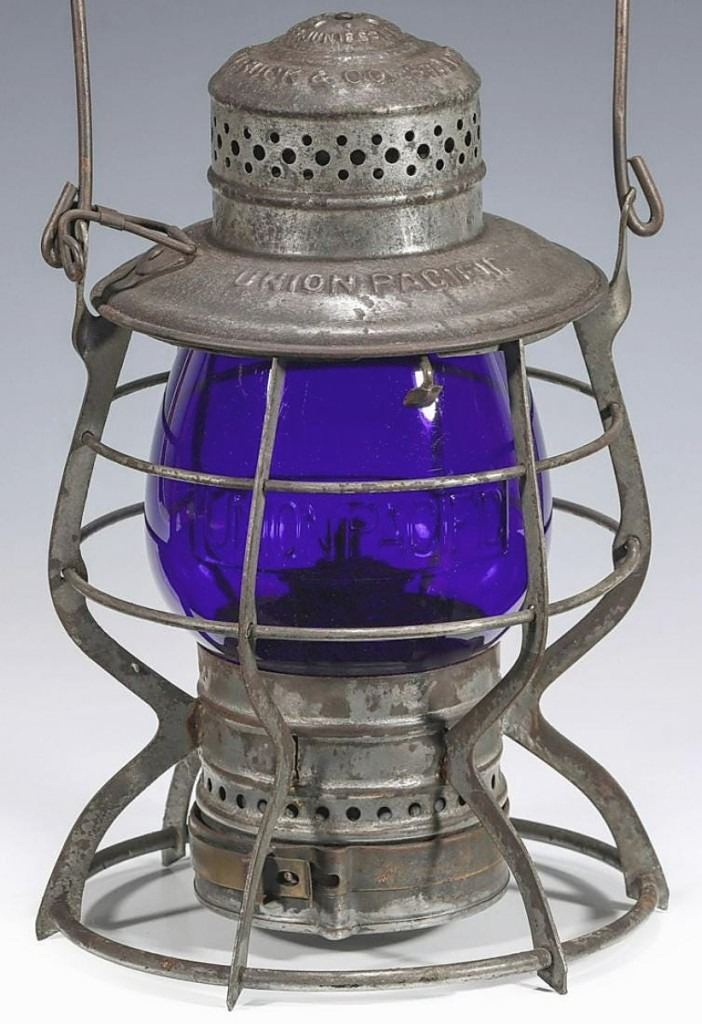
Antiques listed on secondary retail sites and auction websites like eBay, Etsy, and Live Auctioneers range between $9 to $170. There are, however, exceptional listings for as high as $1,000 although there’s no record of any sold for that price.
Last year, Soulis Auction recorded the most expensive antique railroad lantern ever sold at $46,200. It had a unique blue globe meaning it was a hand-signal design.
Antiques and Hearts also noted that the auction house sold eight lanterns for over $10,000 in the same year.
Where to Sell Antique Railroad Lanterns
You can sell antique railroad lanterns on the same websites that sell them. The typical collectors’ go-to are secondary retailers online like eBay and Etsy.
The former has 209 listings while the latter had 676 listings on antique railroad lanterns as at the time of this guide. Alternatively, you can contact independent collectors who resell like Railroadiana which is the biggest antique railway seller online worldwide.
If you prefer physical sales, you can open a garage sale, or add it to your estate.
Antique Railroad Lanterns Selling Tips
It’s always best to sell your old railroad lantern as it is without refurbishing or touching any part. If there are damaged parts, you can track down secondary retailers to find exact models and fittings otherwise, leave it be and notify your buyer of the defect.
Also, note that selling it in its original form doesn’t mean you can’t clean it up and give it a regular facelift. The key is to avoid alterations.
Final Thoughts
When identifying antique and vintage railroad lanterns, you must employ more than one method because some sellers doctor their items.
Are you still confused about determining your antique railroad lantern value? Scroll up and check the factors affecting that again. However, here’s a recap of identifying an old railroad lantern’s worth;
- Check the make and model
- Identify the material
- Note the design





![Where To Sell Antique Furniture In 2022 [Ultimate Guide]](https://www.jacquelinestallone.com/wp-content/uploads/2022/09/Etsy-Your-Place-To-Buy-And-Sell-All-Things-Handmade-600x450.jpg)


